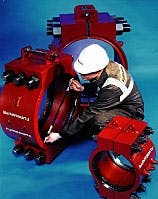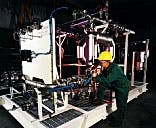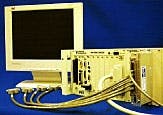Leak-sealing product line for piping systems
The FurmaSeal self-sealing repair clamp is specifically designed to perform leak repairs of pipelines and to encapsulate leaking valves, flanges, and most other components used in onshore and offshore piping.
The clamp consists of self-sealing, high-integrity split pressure vessels that utilize a perimeter elastomer sealing system. Made from several pressure-vessel quality materials, the seal is specifically engineered for long-term repairs. Standard sizes range from 2 in. to 54 in. nominal pipe diameter, and the clamps are available in made to order lengths and configurations. Standard units are designed to work in pressure ranges up to 3,705 psi (ANSI Class 1500).
Source: Furmanite America Inc., Box 1416, La Porte, TX 77572-1416.
Metering skid
This liquid (mass) metering skid embodies gas ultrasonic meters and supervisory control panel. It will be delivered to the North Sea for installation.
Now sited on a gas production platform, the system provides metering of crude oil to an allocation-standard level, to allow precise mass measurement of liquid.
The liquid system incorporates a water-in-oil monitor that provides accurate information about the quality of the crude based on the water content as a percentage of the composition of the flow.
The installation also consists of two ultrasonic multipath flowmeters to meter the produced gas. The unit's accuracy is 1.2%. The system is controlled by a safe area control panel incorporating individual stream flow computers.
Source: Jiskoot Autocontrol Ltd., Tunbridge Wells, Kent, U.K., TN1 2DI.
Logging tool differentiates between oil, water, and gas
A new downhole logging tool combination is capable of real time differentiation between oil, water, and gas in wells with high flow rates. The gas holdup optical sensor tool (GHOST) uses sensing technology to detect and count gas bubbles in a liquid stream, or liquid droplets in a gas stream, providing the data required to calculate the flow rates for each phase.
The tool forms part of the PS Platform logging suite. Four optical probes, positioned 90° apart on the arms of a centralizer-like tool measure the refractive index of the surrounding medium. The position of the probes in space is known through use of an integrated relative bearing sensor. These measurements are used to build an image of the various phase profiles in the well. Operators will be able to measure directly the flow of gas, oil, and water at any chosen location in the well bore. The new tool can obtain accurate results in just two or three passes.
GHOST is particularly suited to a number of applications including small gas entries, liquid entries in gas wells, gas/condensate discrimination, and bubble point detection.
Source: Schlumberger Wireline & Testing, 225 Schlumberger Drive, MD2, Sugar Land, TX 777478.
New strain gauge data acquisition system
The new StrainDAQ system offers a cost-effective way to acquire and process signal variables used in stress testing and strain measurement. Built on National Instruments SCXI or PXI platforms, StrainDAQ offers a modular, versatile solution.
The system is available in two formats. StrainDAQ-px is a PC-based solution utilizing the National Instruments PXI-1010 combination chassis for PXI/CompactPCI and SCXI modules. For customers who already own a PC and wish to add strain gauge and full-bridge data acquisition capabilities, the firm offers the SCXI-based StrainDAQ-sc. Both come with the SES-1200 5 v power supply for excitation and are available with a choice of bridge input configurations and resistance values.
Source: Stress Engineering Services, 13800 Westfair East Drive, Houston, TX 77041-1101.





